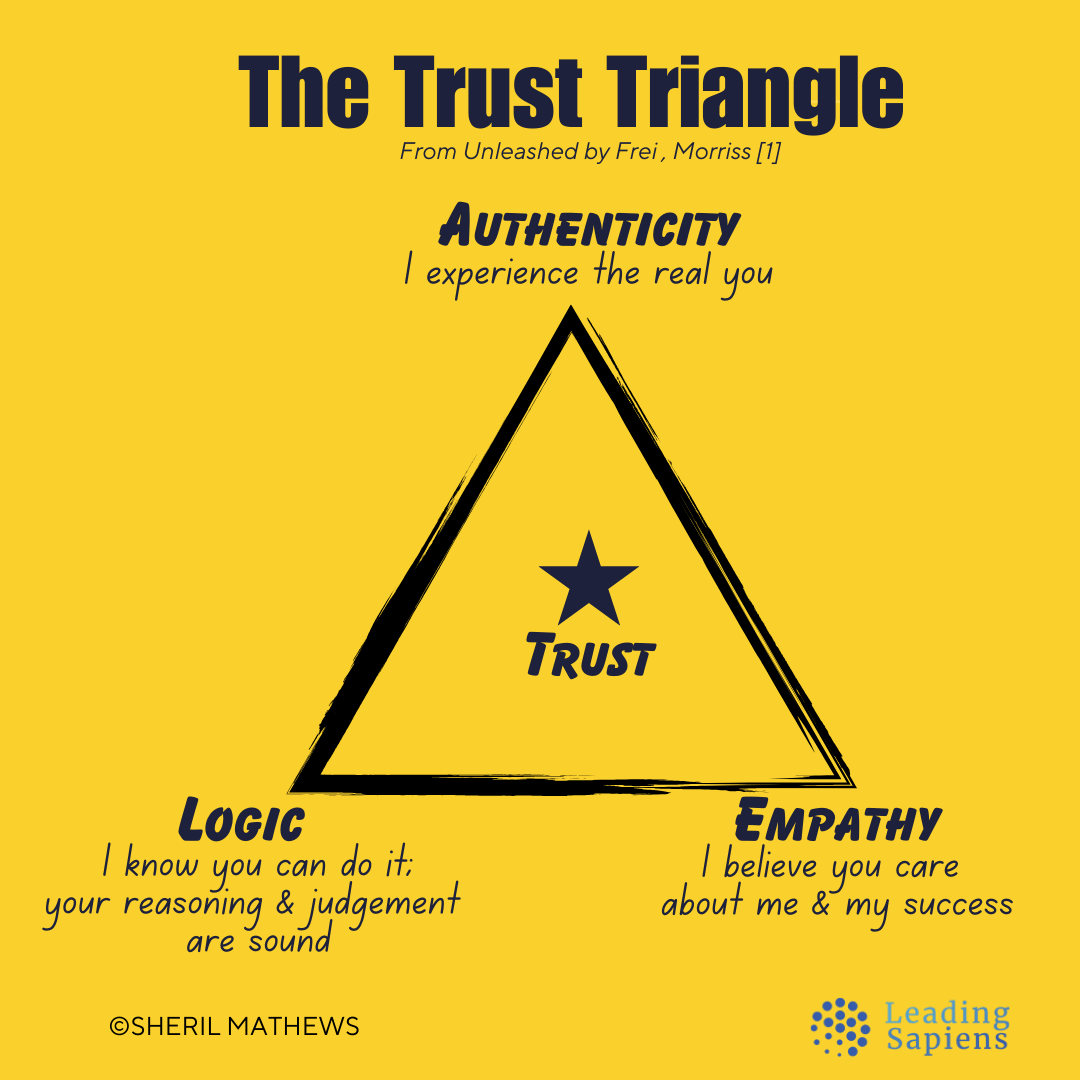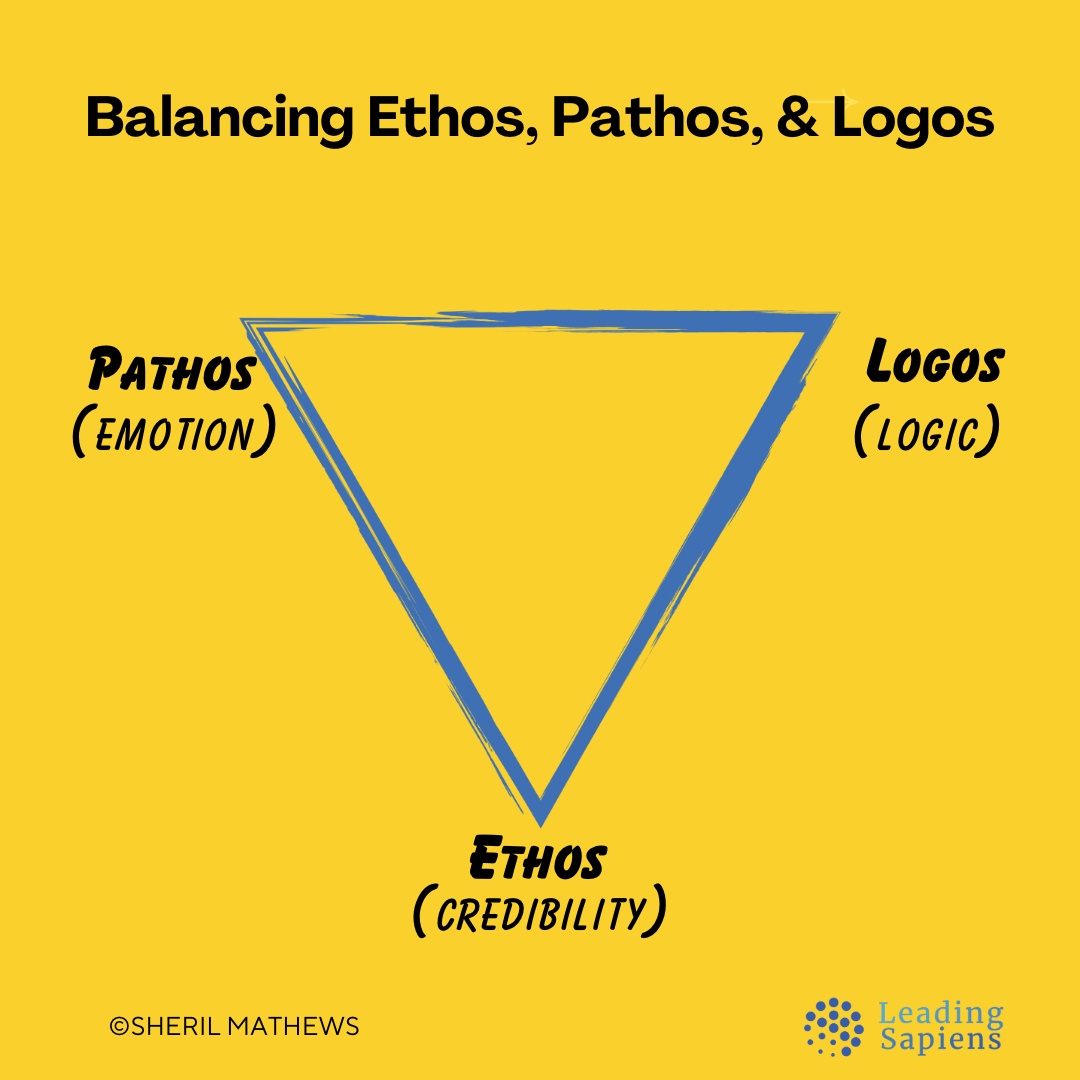How can I be more trustworthy? How do I show up more authentically? Leaders at all levels grapple with this fundamental challenge of leadership. The answer lies in Aristotle's 2,000+ year old framework of ethos, logos, and pathos or what Harvard prof Frances Frei and Anne Morris call the Trust Triangle.
Calling trust the "essential leadership capital", they write:
We think about trust as rare and precious, and yet it’s the basis for almost everything we do as civilized people. Trust is the reason we’re willing to exchange our hard-earned paychecks for goods and services, pledge our lives to another person in marriage, cast a ballot for someone who will represent our interests. We rely on laws and contracts as safety nets, but even those systems are ultimately built on trust in the institutions that enforce them. We don’t know that justice will be served if something goes wrong, but we have enough faith in the system to make deals with relative strangers. It’s not coincidental that trust ultimately found its way into the official US motto, “In God We Trust.” Even if trust in our earthly structures erodes, it’s so vital to the national project that we threw in a higher-order backstop.
...trust is also the input that makes the leadership equation work. If leadership is about empowering others, in your presence and your absence, then trust is the emotional framework that allows that service to be freely exchanged. I’m willing to be led by you because I trust you. I’m willing to give up some of my cherished autonomy and put my well-being in your hands because I trust you. In turn, you’re willing to rely on me because you trust me. You trust that I will make decisions that advance our shared mission, even when you’re not in the room. The more trust that accumulates between us, the better this works.
How do you build up stores of this essential leadership capital? Here’s the basic formula: people tend to trust you when they think they are interacting with the real you (authenticity), when they have faith in your judgment and competence (logic), and when they believe that you care about them (empathy).

Diagnosing your trust pitfalls
Frei and Morriss highlight how when there is a lack of trust it can often be traced back to a breakdown in one or more of the three factors in the Aristotelian triad:
Did they think you might be putting your own interests first? Did the interaction feel all about you? That’s an empathy block.
Did they question the rigor of your analysis or your ability to execute on an ambitious plan? That’s a logic problem.
Or did they think you might be misrepresenting some part of your story, exaggerating the upside or downplaying the risks? That’s an authenticity issue.
Stumbling on Empathy:
Your wobble may be empathy if people often think you care more about yourself than about others. ...this kind of signaling is a major barrier to empowerment leadership. If people think you’re primarily in it for you, then they’re far less willing to be led by you.
Empathy wobbles are common among people who are analytical and driven to learn.
...We advise empathy wobblers to pay close attention to their behavior in group settings, particularly when other people have the floor.
...change your objective from getting what you need in the meeting to making sure everyone else gets what they need. In other words, take radical responsibility for everyone else in the room.
Stumbling on Logic:
Your wobble may be logic if people don’t always have confidence in the rigor of your ideas—or full faith in your ability to deliver on them. The good news is the problem is typically rooted in the perception of wobbly logic rather than the reality of it.
... For most logic wobblers, however, rigor isn’t the issue. A more likely explanation for the breakdown in trust is that you’re not communicating your ideas effectively.
Stumbling on Authenticity:
You may have an authenticity wobble if people feel they’re not getting access to the “real” you, to a full and complete accounting of what you know, think, and feel. If the version of reality you present feels overly curated or strategic, an invisible wall can form between you and the people around you.
We’re not talking about moments of prudent self-censorship, which sometimes can’t be divorced from a larger context of bias or low psychological safety. Instead, we’re talking about inauthenticity as a strategy for navigating the workplace. While this approach may help you solve short-term problems, it puts an artificial cap on trust and, by extension, your ability to lead. If we sense you’re withholding the truth or concealing your authentic self, if we don’t know what your genuine beliefs and values are, then we’re far less willing to make ourselves vulnerable to you in the ways that leadership demands.
As Virginia Satir put it:
To be trustable I don't need to be perfect, I need to be real.
Showing up authentically
As I noted in my piece on ethos, pathos, and logos, the whole edifice crashes if there's not enough trust and credibility. This makes ethos the base of the inverted triangle:

Authenticity however is a paradox in leadership and without easy answers. E.g. you want to develop your people, but you're also the one evaluating them. You care, but not at the price of the ultimate goal.
Frei and Morriss give the following pointers to increase your authenticity so you show up as a human leader and not a managerial automaton:
- Regaining control from our primal brain: The survival-oriented part of our brain is excellent at protection but shouldn't always be in charge. It often misjudges threats and focuses on short-term survival rather than long-term goals. Buddhism and modern mindfulness offer tools to help manage this part of our minds. It's worth exploring these practices.
- Authenticity triggers: Uncover the people or things that bring out your true self. Whether it's a loved one, a passion, or a hobby, keep these reminders close, especially in situations where you might otherwise be inauthentic. Incorporating personal stories or passions into professional scenarios helps in coming across as genuine and relatable instead of a corporate automaton.
- Abandon the script: Balance logic with authenticity. While being informed and articulate is valuable, trust is built when people can see the person behind the talking points. Practice being unscripted in low-risk settings, and gradually increase the stakes as you become more comfortable. I've explored this notion in my piece on self-disclosure.
- Share your “why”: Communicate what drives you as a leader. Sharing your core motivations builds trust, as it prevents others from making their own, possibly incorrect, assumptions about your own motivations.
- Learn publicly: Allow yourself to change your views based on new information and experiences, and do so openly. This shows authenticity and encourages others to keep an open mind as well. You are in effect modeling the very behavior that you want your teams to embody.
- Build a supportive team: Authenticity thrives in a team environment. Surround yourself with friends and colleagues who help you stay true to yourself. Regularly spend time with this team to maintain your authenticity.
- Empower others: Focus on empowering others as a leader. The more you shift the focus away from yourself, the more your authentic self can emerge, enabling effective leadership.
Trust issues in the organization
Ethos, logos, and pathos, and by extension the trust triangle, is equally applicable at the organizational level. A lack of any of the essential elements leads to what Frei and Morriss call "trust wobbles" at the org level.
They give a checklist of the most common trust pitfalls in organizations and what might be causing it:
- Aversion to making choices: Trying to please everyone or aiming to excel in all areas often leads to mediocrity. Failing to make definitive choices may feel safer, but it increases the risk of underperformance. Trust wobble: logic.
- Reliance on heroic employees: Too often, business models are designed for ideal employees, not the ones you actually have. If your operations depend on employees consistently exceeding expectations, you'll need to invest heavily in finding and compensating these rare individuals – a task most organizations struggle with. Trust wobble: logic.
- Shiny object syndrome: The human tendency to chase new opportunities can endanger your business model. Lack of discipline in pursuing new ventures often leads to inflated expectations and neglect of more pressing priorities, increasing risks. Trust wobble: logic.
- Disengaged middle management: Middle managers often understand the gap between a company's goals and reality but are frequently overlooked during major changes. This oversight hinders the organization's ability to navigate challenges. Trust wobble: empathy.
- Casual relationship with other people’s time: Many organizations waste employees' time on outdated practices and inefficient processes, leading to significant opportunity costs. Leaders must treat employees' time as a strategic asset. Trust wobble: empathy.
- Comfort with collateral damage: A culture that tolerates unintentional harm, justified by a "we tried our best" mentality, can become desensitized to the consequences. This attitude is unacceptable in other areas of business and shouldn't be tolerated when it affects people. Trust wobble: empathy.
- High incidence of the “Sunday scaries”: Widespread anxiety about returning to work indicates a deeper organizational issue. This strain on employees reduces their ability to contribute fully and needs to be addressed at the organizational level. Trust wobble: empathy.
- People-pleasing in the boardroom: The habit of telling decision-makers what they want to hear, rather than the full truth, undermines trust. Leaders need accurate information to solve problems, and withholding or massaging reality damages trust. Trust wobble: authenticity.
- Tolerance for misalignment: Misalignment between different parts of the organization, especially between strategy and culture can create significant problems. For example, an innovative strategy won’t succeed in a culture that resists change. Trust wobble: authenticity.
- Delusions of meritocracy: Claiming to be a meritocracy while consistently promoting the same types of people is misleading. If leadership doesn’t reflect the diversity of the broader workforce or customer base, the claim of meritocracy is false. Trust wobble: authenticity.
While I've focused on Aristotle's framework in this post, both books (see sources) by Frei and Morriss are well worth the read in their entirety, and packed with practical insights that managers can implement right away. Highly recommended.
Related reading
- An in-depth look at what ethos, pathos, logos means in modern leadership
- The Johari Window method for diagnosing leadership blindspots
- Authentic leadership as knowing how your people get work done
- Warren Bennis on authenticity in leadership
- The role of time in authentic leadership
- Leaders as gardeners
- What drives human beings
- Why we copy leaders
- How framing creates psychological safety
Sources
- Unleashed: The Unapologetic Leader’s Guide to Empowering Everyone Around You by Frances Frei and Anne Morriss
- Move Fast & Fix Things: The Trusted Leader’s Guide to Solving Hard Problems by Frances Frei and Anne Morriss
- Frei and Morriss' article in HBR on the trust triangle.


